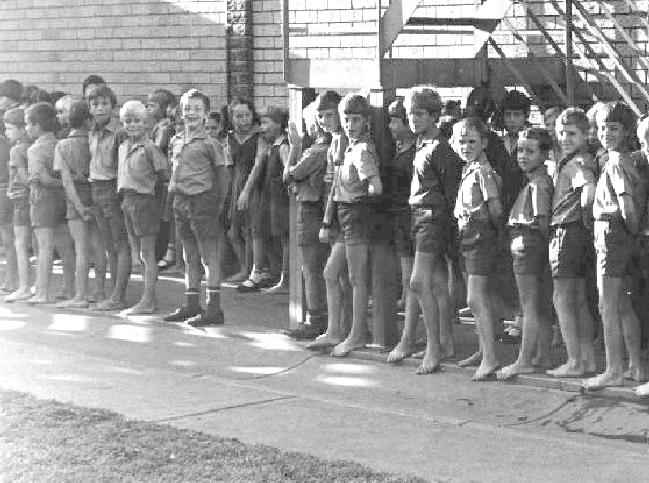
Figure 1.--Here we see children at the Goudkop Primary School lining up at the begiining of the school day. The image is undated, but look like the 1960s. |

|
South African schools had a wide range of uniform requirements for specific activities. They are the same activities persued by children around the world. Images of these activities over time provide interesting glimpses of South African school uniforms and schoowear in general. We still have relatively few limited images of South African schools, but are gradually expanding our archive. We notice quite a range of actibities at South African schools in addition to rge standard academic classrom activities. we notice art, dance, sports, and a range of other activity programs. Hopefully our South African readers will provide us more information on activities at South African schools.
Many South African children walked to school. We also see them lining up at the begging of the school day. Uniform conventions vary from school to school. At some schools boys would come to schools in their blazers and ties. At other schools we notice the children coming to school in much more basic uniforms. We note boys wearing grey open-neck shirts and grey short pants. These are the same clothes that the children would wear during the school day. Some images show most of the children barefoot, but this appears somewhat less common in the 2000s. YThese basic uniforms may have been more common in the more rural schools.
Most schools had the boys just wear their shirts and during the Wnter their jumpers while in class. Boys did not commonly wear their blazrers in class. Some class room activities like art or science might require some sort of protective gear.
Our informationon dance in South African schools is very limited at this time. We suspect it was not very important in white scholls during the Apartheid period. We are less sure abougt the colored and black schools. Dance was certainly important culturally in the black tribal communities. Many African tribes had elaborate costumed dances, often associated with with ritual and mythology. We do not know to what extent it was included in the school program. Since South Africa has become a democratic nation we note that many schools have involved dance in the program. Presumavly this is most pronounced in rural areas where the tribal influence is most pronounced, but un fact we do not have a lot of information. We do notice images of Dance activities in schools. Hopefully our South african readers will provide us more information.
Fielf trips are generally very populae with the children. Schools tended to have definite rules about how the children should dress on these trips. The South African students here in the early 2000s are on a field trip. Some schools insist the children wear their blazers and full school uniform for such trips (figure 1).
Many schools had a gym uniform.
Many schools sponsored a range of music activities. Boys could take instrumental music lessons. Schools varied as to the emphasis placed on this. There were often various kinnds of music appreciation classes. Many schools sponsored bands or orchestras. Some schools, primarily larger scecondary schools, had quite impressive orchestras. There might also be smaller ensembles of various kinfs depending on the interest of the faculty and students. Older bopys might form bands in their spare time. The types of bands varied as to the type of music that was popular at the time.
Some South African schools had outward bound programs. We are npt entirely what the pograms were called, but we note images of the children or cimando or survival courses. This seems to be an individual school activity rather than part of any national program. It may be done as a kind of camp rather than after school activity, but we have few details at this point. We do not know how common these progeams are. This may be an activity most common in the Afrikaans speking school, but we are not sure about this.
The sports popular in South Africa are the same as those popular in England. We note boys playing cricket, football (soccer), and rugby. Soccer has becomne increasingly popular in recent years, although rugby and cricket are also very important. In addotion a variety of other team sports like basketball are also played. In addition there are many indivisual sports. As far as we know only the major world team sports are played, especially those of English origin. We do not know any local African games that are played./ There were of course a variety of specialized uniform for various team sports. The uniforms are the stanndard oines developed in England. We do not know of any destinctive South African uniform items.
Quite a number of schools sponsored youth group units such as Scouts. Some secondary schools had Cadet units.
Related Chronolgy Pages in the Boys' Historical Web Site
[Main Chronology Page]
[The 1900s]
[The 1910s]
[The 1920s]
[The 1930s]
[The 1940s]
[The 1950s]
[The 1960s]
[The 1970s]
Navigate the Relate Boys Historical Clothing Style Pages
[Main country page]
[Long pants suits]
[Short pants suits]
[Lederhosen]
[Kneesocks]
[Eton suits]
[Jacket and trousers]
[Blazer
[School sandals]
Navigate the Boys' Historical Clothing Web Page
[Introduction]
[Activities]
[Biographies]
[Chronology]
[Clothing styles]
[Bibliographies]
[Contributions]
[FAQs]
[Glossary]
[Images]
[Links]
[Registration]
[Tools]
[Boys' Clothing Home]
